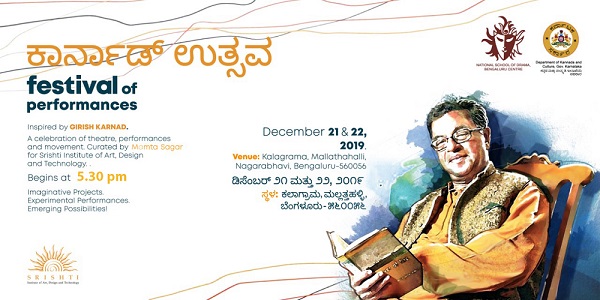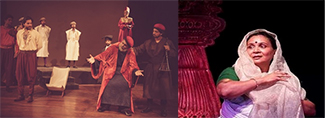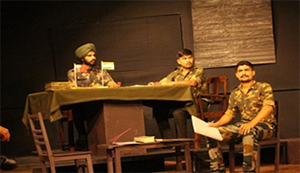Mamta Sagar
Mamta Sagar

Image credit - Dr. Reshma Ramesh
A decade long Kannada literary sensibilities experienced through translations
It was in the last decade that Bangalore became Bengaluru, Mysore as Mysuru, and Hubli as Hubballi. ‘Reclaiming’ can be one of the principal themes that could be identified to represent a decade long Kannada experience. Translation in general and in the context of literature is usually understood as an exchange, creation and recreation that takes place between languages and their creative writing engagements. Perspectives of looking at translations have been altered, transformed and replaced all along these years. Gone are those days when we were taught lessons of ‘lost in translations’. In actuality translations reveal what the original cannot. Lodging a text, a narrative from one linguistic culture into another or from one form of artistic rendition into yet another allows one to tell tales of one’s times alerting their readers and audiences. Kannada was a witness to this phenomenon over the last decade.
The 2010s through and through have been beyond interesting, challenging, vibrant and innovative. A decade long of Kannada literary sensibilities are nurtured through exposure to the socio-political and cultural proceedings within the country and the state of Karnataka. This edition tries to showcase the journey of a linguistic culture and the exclusive experiences it has walked by; creating and recreating texts that would help us realise the backgrounds we have been living against. Here, translation is understood along the diverse possibilities of recreating texts that further allow us to realise the significance of our times and what it has been voicing.
Translation Activities:
PRINT: The translation academy that started in Karnataka was the first of its kind and was taken under the larger umbrella of Kuvempu Bhasha Bharati Pradhikara (May 2009), a major state owned institution that has been promoting translations from and into Kannada. They sponsor translation projects and host workshops where Kannada writers are invited to participate and support young translators through fellowships. Bhasha Bharati has constituted translation awards considered to be prestigious. Many other independent publishers like Ila Prakashana, Srushti Prakashana, Chanda Pustaka, Avadhi, Aharnishi, Vikasa Prakashana, Anaya Prakashana, Kavi Prakashana, Vimochana are among the increasing list of many big and small publishers who have been contributing to new sensibilities by publishing translations or translating current and relevant issues around gender, caste, historical, political and social issues. Some of the important translations from Kannada that have been into English and other Indian languages are introduced in this issue.

Elif Shafak’s Forty Rules of Love trans. into Kannada by Mamta Sagar
MUSIC: Bhakti seems to be an effective social critiquing tool used even today. Vachanas and Dasara Padas dated back to the 12th and 15th centuries are presented and produced in new compositions. The recurring yet pressing issues of gender, caste and corruption are addressed in these lyrical pieces. When these classical texts get translated into a new medium of expression, they imbibe new meanings and get transformed into new translations with contemporary intentions. Poems by contemporary poets are also composed and sung. Bindumalini Narayanaswamy and Omkar Hawaldar have been part of Saath-Saath: Music Across the Waters (2016) a India-Hong Kong ongoing collaborative project curated by Tejaswini Niranjana where Chinese poets and musicians collaborate with Indian musicians to come up with new forms of music. The Threshold (2019) and Marathalli Rani (2019) are exclusively feminist approaches to making music. I have been working with Vasu Dixit for the past few years and our collaboration writes a perceptibly unique text of my poems.
THEATRE: The regional centre of the National School of Drama under the directorship of Basu (Basavalingaiah) has been experimenting with plays in translation from Indian and foreign languages produced in Kannada. The grand production of KuVemPu’s acclaimed novel, MalegaLalli MadumagaLu (2010), a nine-hour theatrical text directed by Basu was produced. This production, the visual translation has been a memorable experience for the audience.
KARNAD UTSAVA (December 2019) was yet another massive translation project curated by me and designed in the form of a carnival. This was an international festival curated for Srishti Institute in a month-long collaboration with NSD. Selected artists, musicians, filmmakers and writers were invited from India and around the world to work on themes emerging out of Girish Karnad’s body of work. Artists from diverse art practices engaged with more than 250 students and evolved their performative works in relation to the life and works of the legendary Girish Karnad. Folk, myth, history, duality and the magical are some elements identified as connecting dots. The carnival took the audience through music, documentary, movement art and theatre. Participants received exposure to performing arts like Yakshagaana, Mallakambha, Rope Mallakambha while classes on acting and rigorous training sessions were also offered to resident students at the prestigious drama school. The site-specific multilingual productions were spread over the lush green Kalagrama campus.

Karnad Utsav
Sanchari Theatre established in 2014, is one of the leading theatre groups based out of Bengaluru promoting theatre activities, productions and workshops on acting, theatre music, theatre designs pertaining to sets, properties, costumes, lights, make up, etc. They focus on engaging children and youth in theatre. “An acute awareness of the role of theatre in the ever changing human world has been the driving force behind the choice of our plays”, says Mangala N, initiator and founder of this group. Sanchari adapts literary texts and translations into theatrical performances. Their recent play was "Veniccina Vyaapaara" (2015) based on a translation of Shakespear's Merchant of Venice by KV Akshara.

Sanchari’s Veniccina Vyaapaara and N Mangala Sanchari
Abhinaya Taranga is yet another leading Theatre Training School in Bangalore. They have been producing Kannada plays, translations, adaptations from poetry, short stories etc. Abhinaya Taranga is bent upon making quality theatre education accessible to theatre aspirants from diverse backgrounds of the society. “The institute aims at creating a learning environment that fosters meaningful work, whilst preparing its students to be courageous, innovative artists with integrity.” says Gowri Dattu of Abhinaya Taranga. Their recent production was Bhisham Sahni’s Muavze (2021), translated by Ashwini Ranga.

Bhisham Sahni’s Muavze
New experiments of telling translated political stories are thriving in theatre. Bhagirathi Bai Kadam took over as the director of Rangayana, Mysuru. Kruti R based out of Heggodu founded an all women group, YAKSHADURGA BALAGA to claim spaces for women singing Talamaddale in Yakshagana performances, which is otherwise reserved for men alone. Sharanya Ramprakash combines traditional and present day narratives into weaving contemporary performativity narratives.
Thanks to organisations like India Foundation of Arts, The Toto Funds, The Arts among others for supporting artists and writers with small funds towards sustaining their arts, crafts and socio-political stances.
FILMS: The Kannada film industry has witnessed a newer and more profound wave in the last decade. Young and innovative debutant filmmakers and actors have created path breaking films and given memorable performances. Lucia by Pawan Kumar, Tithi by Raam Reddy, Harikatha Prasanga by Ananya Kasaravalli, ULidavaru Kandante by Rakshit Shetty, Naticharami by Manju Mansore are a few to name. Films based on literary texts with screenplays written towards translating visual narratives are Girish Kasaravalli’s Kanasembo Kudureyaneri based on Amaresh Nudgoni’s story, Kiragoorina GayyaLigaLu by Sumana Kittur based on Poornachandra Tejaswi’s novel, AVVA by Kavita Lankesh based on the story and screenplay by the legendary P Lankesh, Aa DinagaLu by KM Chaitanya based on the novel Daadaagiriya Dinagalu by Agni Shridhar are a few names to count on and the list is increasing film by film. Once again watching Kannada films has been a pleasure and this fresh Kannada cinema is also loved by non-kannada speaking audiences whose trusted source of learning Kannada is through these more universal films.
THE PUBLIC PLACES: Translation blooms in public places for several reasons. Site specific poetry installations, storytelling sessions, one-person performances, poetry readings and many more include common people into the envelope of literary expressions. 2019 saw poems translate into protest songs resisting oppressions and atrocities. The most popular one has been Faiz Ahmed Faiz’s Hum Dekhenge (first published in 1981). Versions of this poem in Kannada echoed on the streets. They went viral and were sung at protest sites like Town Hall, Bilal Bagh and gatherings at street corners which were brimming with poetry and songs. Poet Siraj Bisralli was arrested for his poem asking for the document during people’s protests against the CAA & NRC. Writing poems, especially those showing concerns to the migrants, farmer’s protests, suppressed and oppressed communities and the arrested were floating all over the protest skies. New poems were written as poems from Kannada literary traditions resurfaced as novel forms voicing subjugated people and communities. Protest poetry has successfully managed to document socio-political implications of this land. Translation is indeed the need of time when the seemingly connected world seems more divided than ever before. It happens only when the demand for it becomes more and more conspicuous for varied and sometimes unrecognisable reasons. Apart from the already existing Ranga Shankara, 1 Shanti Road, Jaga Art Studio and other dedicated performance spaces, new venues like The Courtyard and Bangalore International Centre opened up and have been hosting several literary and translation events.
We have had the opportunity to create poetry installations at the Cubbon Park and the Chickpet metro stations. Kaavya Sanje, a multilingual poetry community engagement that I curate which sees many poets from diverse linguistic backgrounds participate actively and regularly. We have performed and installed poetry in public spaces in Bengaluru. Kaavya Sanje’s attempt to collaborate with Art In Transit in 2019 and conduct workshops for the well-digging Bovi community has resulted with poets from Kaavya Sanje writing poems based on community experiences and narrative. These poems have been painted as part of the mural displayed at the Cubbon Park Metro Station for commuters to have an access to the story of water in the city of Bengaluru. Not only was that task a reminder to respect and revere communities that have indigenous ancient knowledge on underground water, but also a reminder to re-look and re-assess incessant wastage of water in the times of erratic and more visible climate change and global warming
TRANSLATIONS TRAVERSING BOUNDARIES: Some of us have been part of international translation projects. Literature Across frontiers - Wales (2013-21), Melding Voices - England (2014-15), Poets Translating Poets - Germany (2016), The Commonwealth Foundation - UK (2019-21) are four major translation forums I have been involved with in the last decade. I have thoroughly enjoyed translating poets from diverse small and big languages both international and Indian. Introducing these translations to Kannada audiences has been a challenge. These translations are used in poetry translation and performance workshops of Kaavya Sanje.
THE ONLINE: It has been the ‘social media decade’ for Indian languages. Smart phones, internet accessibility, emojis, easy and swift editing and everything seeming to be at our fingertips, e-literature has been made easily available in Kannada. Usage of Kannada in blogs and social media handles became the natural next step. New syntax structures and the forming of new slangs have started surfacing in Kannada writings. Mobile phones, email IDs, laptops, FB & Instagram posts, have now become part and parcel of contexts, themes and plots in Kannada writings. Many young and aspiring writers experimenting with genres and languages have surfaced in the Kannada context. Online forums, journals, events that break conventional literary setups have sprung up automatically. Suddenly e-literature in Kannada is seen occupying and spreading on online platforms. Writers not only publish their poems and short narrative, but also post their shared concerns about the socio-political norms through their writings. The online activity has made way for new evolved ideas, to be translated into the Kannada culture of our times.
THE LOCKDOWN: The lockdown due to pandemic has been a strange time for artistic pursuits. It all began with the CAA & NRC protests being silenced by the pandemic. When the actual public places were unavailable, virtual space was turned towards. As against the homebound lonely art making, collaborative works and the interdisciplinary practices emerged abundantly. It seemed as if the world had shrunk and everyone knew every other person in the world. One's practice is enriched with the exposure to many perspectives beyond one's reach which otherwise was not that important or possible. However, the larger canvas of life was reduced to merely a computer screen. Online literary events, translation activities, an exchange of thoughts opened up. Art practices had to rethink and etch paths anew and feasible. Poet MR Kamala hosted poetry events, Maatukathe on her own home’s terrace. Storytelling became a popular genre. A group of young writers ventured into reading and discussing short stories in public places and took to virtual space during the lockdown. They now invited authors to present their stories online under the banner, Kathe Heltivi Banni. Book Brahma, Avadhi, and several other popular publishers have launched their publication online during the pandemic.
Kaavya Sanje too went online. In around twenty to thirty online sessions, we had more than three hundred poets participating and presenting from all over the world. Connection between Indian and world languages seemed much closer. Multilingual spaces boomed and celebrating diversity seemed to fly high. My practice as a poet and translator moved beyond whatever I was doing. I co-curated the Rucksack at Global Poetry Patchwork, an Art-Poetry installation project with artist Antje Stehn for the Piccolo Museo della Poesia, in Piacenza (Poetry Museum), Italy. Poems by twenty-eight poets from fifteen Indian languages were showcased among the 250 representative poets from over the world. Pandemic has taught us how life is problematic and challenging. It also taught us how art practices can take different forms and how artists are resilient and strong individuals who find newer and earlier unimaginable ways to practice and present their art
FESTIVALS: Apart from the Bangalore Literature Festival and the Bengaluru Poetry Festival; the 2010’s saw a few very fine local literature festivals organised in small towns and villages far from the capital cities of Indian states. Sahitya Sambhrama at Dharwad (2013), May Sahithya Mela at Gadag (2013), Ha.Ma. Bhatt Memorial Literature Festival at Tumari village (2012), Pampa Literature Festival at Chengannur (2014) are a few praiseworthy examples of many of them showcasing translation works in and out of Kannada. Contrary to how one may imagine as for the rural areas being disconnected and isolated, many of the festivals went online and reached international shores and audiences during the lockdown.
MEMORIALS: Social media was thronged with poems, notes and texts written as memorials condemning assassination of journalist Gauri Lankesh and Prof. MM Kalburgi. Kannada lost its literary stalwarts UR Anathamurthy, GS Shivarudrappa, Girish Karnad and Nissar Ahmed in the decade that went by. They continue to be remembered, admired, discussed and revered for their contribution here through their works in translation.
This edition would not have been possible without the unconditional support of translators, musicians, writers, theatre practitioners, poets and artists who have taken time to contribute their write ups and videos. Thanks to poet and photographer Reshma Ramesh for allowing us to use her work. I would like to specially acknowledge the help of poet and designer Shashank Johri who made my work much easier by being with me in the editing task all through. Last but not least is a heartfelt appreciation that I have for Annapurna Sharma’s patience. Wishing our readers a good read. Thank you!

Issue 96 (Mar-Apr 2021)
-
ARTICLES
- Arjun Sajnani: The making of ‘Crossing to Talikota’
- Deepa Ganesh: More richer than my tongue
- Ekta M: The unregistered protest of a poet – Imagining the world of Kotiganahalli Ramaiah, a renowned Dalit poet, playwright and pedagogue
- GS Shiva Prasad: Translation vs Transcreation – My personal anecdotes
- K. Nallathambi: Translation
- Kamalakar Bhatt: Translation Choices: Ranging the Horizons of Possibility
- Karthik R: No Presents Please - Mumbai Stories
- Karthik R: Queering Kannada Literature – Mohanaswamy and the Decade Gone By
- Keerti Ramachandra: Translating Hindutva or Hind Swaraj by U R Ananthamurthy
- Kirtana Kumar: “Who is Marathahalli Rani?”
- Maithreyi Karnoor: I am not a prolific translator and I want to stay that way
- Mohan Varma: On translating Mamta Sagar’s Hide and Seek
- Mysore Nataraja: Translation is Also Original!
- Nayana Kashyap: Translating Vaidehi
- Preethi Nagaraj: Ceylon Cycle – an anthology of short stories by Kanakaraj Balasubramanyam
- Satya S: A Journey through translation with ‘Foot Soldier of the Constitution.’[i]’
- Vaishali KS: Translating Orhan Pamuk’s Snow into Kannada
- Vanamala Viswanatha: When Satya Harishchandra speaks in English…
- Vijaykumar Shetty: Online Kannada Portals
-
FILM PERFORMANCE
- Mamta Sagar: Interversions 3
- Mamta Sagar: Knock on the Door
- Mamta Sagar: Poetry performance at a public place
- Wilson Kateel: A Poem on War Zone
-
MUSIC POETRY
- Bindhumalini: Innevanavva
- Mamta Sagar and Vasu Dixit: For Gauri
- MD Pallavi: Sule Sunkavva
- MD Pallavi: Threshold – a journey into the unheard
- Sunitha Ananthaswamy: Sakhane
- Vasu Dixit: Lies
-
POETRY
- Bhageerathi – Janapada poem trans by Shashank Johri
- Chandini Gagan
- Chetana Tirthalli
- Dadapeer Jyman
- GS Shivarudrappa
- Kavichandra
- Nissar Ahmed
- Rajendra Prasad
- Siddartha
- Siraj Bisaralli
- Tina Shashikanth
-
STORIES
- Kanaka Raju: Ceylon Cycle – Translated from Kannada by Preethi Nagaraj
- Sunanda Kadame: Kitchen Paradise – Translated from Kannada by KS Poornima
- Editorial
- EDITORIAL
- EDITORIAL
- EDITORIAL
- EDITORIAL
